
Original Link: https://www.anandtech.com/show/2328
Swiftech H2O-120 Compact and Corsair Nautilus 500: Is Water Better?
by Wesley Fink on September 17, 2007 6:00 AM EST- Posted in
- Cases/Cooling/PSUs
A few years ago any discussion of which was better - water or air - would inevitably end in the conclusion that water was better than even the best air coolers. In fact, many would have considered it heresy to even raise the question. We are told from many directions today that water cooling is superior, and yet there are few direct comparisons of the performance of water and current air cooling.
There have been many advances in air cooling in the last few years - so much so that the best current air coolers bear almost no resemblance to yesterday's air coolers. The top air cooler of yesterday was a configuration with a small, whining, top-mounted fan with a heavy copper heatsink and no heatpipes. This is a far cry from today's best air coolers. Now the most successful of current air cooler designs feature heatpipe towers with quiet side-mounted 120mm fans blowing toward a rear exhaust.
The multiple liquid-filled heatpipes and the large, quiet, high-output fans in use today have taken air cooling to new performance levels. Our testing here at AnandTech supports the vastly superior performance of the heatpipe tower compared to the older air cooling designs. With these results in mind, it is time to revisit the question: is water cooling still the best performer?
Certainly the reasonably priced self-contained water coolers have provided mixed test results compared to the top air coolers. The small Xigmatek AIO provided good results for its size, but the larger Evercool Silver Knight was somewhat disappointing in performance. It was reasonably clear in test results though, that the self-contained units could compete in the notch below the top of the tested air coolers, but not the top air coolers of today. None of the self-contained water coolers really cooled better or could reach the same high overclocks we saw with the best air designs. This raised the question of how "real" water cooling systems would compare.
Water cooler designs have not been completely static while air cooler design has been evolving. Water cooling manufacturers have been working toward simpler designs that are less intimidating for the average computer enthusiast. This involves several different approaches. Some look to move all of the water cooling components inside the case while others are looking at new ways to move water cooling outside the case; we will be looking at both approaches today, the former with the Swiftech H2O120 Compact and the latter with the Corsair Nautilus 500. Whichever approach they have taken, the water cooler manufacturers claim combining complete top-line pumps, waterblocks, reservoirs and radiators has resulted in top-line water cooling results with a much easier installation than traditional water cooling.
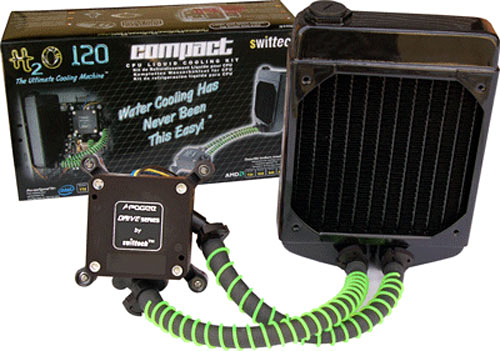
The Swiftech H2O-120 Compact combines water cooling components inside the case. Swiftech reduces the traditional four components of a water cooling system to two components. The water block and water pump are combined into the Apogee Drive Block and the radiator and reservoir are combined. By merging components the H2O Compact requires just one set of connecting hoses in the water cooling system.
According to Swiftech this simplified water system still uses the top individual components in the combined components so performance is not compromised. The simpler H2O-120 Compact also claims much easier installation, with just 15 to 20 minutes required for a complete internal installation. All of this water cooling performance also comes at a cheaper price than is typically seen with a water cooling kit. The H2O Compact was just introduced and is selling for around $150, but Swiftech tells us they expect the street price for the H2O-120 Compact kit to settle in at around $129.
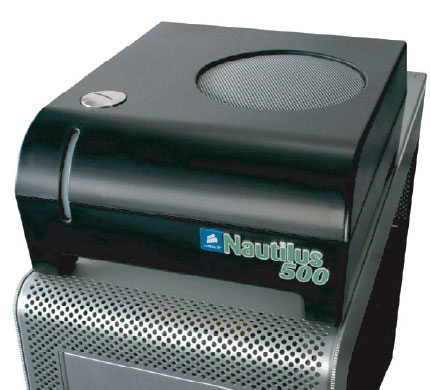
The Corsair Nautilus 500 uses a different approach to easier installation. Components remain similar to the more traditional water cooling parts, but everything except the CPU water block is integrated into an external cooling appliance. This also reduces water connections to two tubes for a much simpler and faster installation. Corsair claims the Nautilus 500 can be installed in 8 minutes, which is certainly as fast as most air cooling installs.
The Corsair Nautilus 500 also comes at a cheaper price than many other water cooling kits. Where most kits are in the $200 or higher price range, the Corsair sells for about $150 or even less. This places the Nautilus 500 in the same basic price group as the H2O-120 Compact.
Both Corsair and Swiftech claim they have not compromised in quality or performance with the simpler-to-install systems. Both say they combine top-line pumps, water blocks, reservoirs and radiators to insure top-line water cooling results with a much easier installation than traditional water cooling. In fact it appears both Corsair and Swiftech use similar components in their systems that are arranged in different configurations.
The big question then is performance. Do the Swiftech H2O-120 Compact and Corsair Nautilus 500 actually outperform the top air coolers? Are they quieter than today's best air coolers as advocates of water cooling claim? These are not frivolous questions since either water system costs two to three times the price of the top air coolers. Finally, are there other advantages to these water systems that make them a better choice even if performance is less than standout? Do the Compact H2O and/or the Nautilus 500 claim the title of best cooling system tested at AnandTech?
Swiftech H2O-120 Compact
Swiftech specializes in cooling for the enthusiast market. It is probably best known for its liquid cooling solutions, but Swiftech began with air cooling and has also had a few air coolers that were very well-known, like their ongoing MC and MCX air coolers for AMD and Intel. Swiftech also markets thermoelectric cooling parts, specialty ram and MOSFET coolers, and even a specially modified Antec P180 case called the QPower P180 for water cooling.
The Company was founded in 1994 by Gabriel Rouchon, incorporated in 2001, and was first publicly traded in 2005. Though there have been many changes in the company's structure over the years, it is worth mentioning that Gabe Rouchon is still very active in Swiftech, and Gabe often works directly with reviewers on tweaking the company's cooling products.
Swiftech markets both individual cooling products such as CPU water blocks, chipset and VGA water blocks, pumps, radiators, reservoirs, and cooling accessories. They also market complete water cooling kits such as the H2O-220 Apex Ultra and the H2O-80 Micro. Their newest kit, the H2O-120 Compact is the subject of this review.

The complete H2O-120 Compact kit comes packaged in a small box measuring roughly 13x7x4 inches. Everything needed for a standard Intel or AMD installation is included in the package.
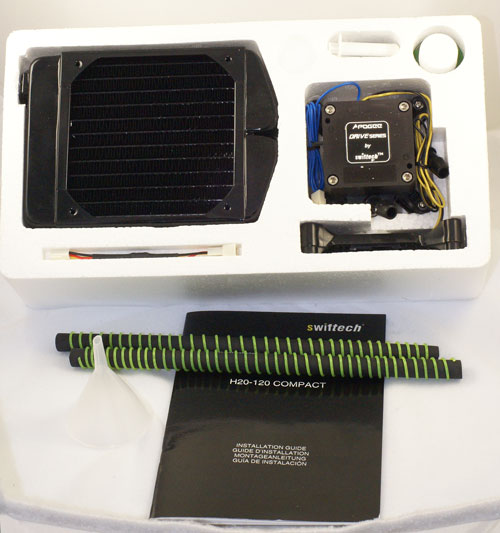
The radiator/reservoir and water block/pump are well protected by the cutouts in the rigid foam block. Components are located on both the top and bottom of the Styrofoam. If you can't find the funnel it's mounted on the bottom.

You can see how much Swiftech has simplified this water cooling system by looking at the small number of parts compared to traditional water cooling kits. The fan/radiator/reservoir is basically one module, and the water block/pump is the second module. These two components are connected by pre-cut 10" Neoprene 3/8" tubes. All of the hardware for mounting is included, such as the mounting screws, Intel backplate (shipped attached to the Apogee Drive Block), a 7V electrical connector for running the fan at low speed, Arctic Silver Ceramic thermal grease, and the water additive. An alternate mounting block is also included for AMD/AM2 processor mounting.
Swiftech does not include the distilled water required for filling the system. Specialty cooling etailers and scientific equipment shops carry this; however, the most readily available source for distilled water we found is Wal-Mart, where a gallon of distilled water was less than a buck. The coolant additive is mixed with a half liter (pint or 16 oz.) of distilled water.
Installation
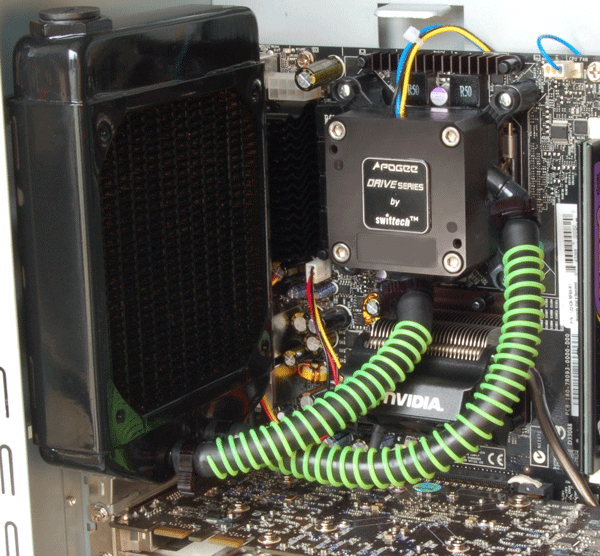
The kit mounts just fine in a full tower case, and it will mount fine in an Antec P180 which mounts the power supply at the bottom of the mid-tower case. The kit as supplied did fit any bottom-mount mid-tower case available for testing. However, the Swiftech H2O-120 Compact kit would not fit any top-mount power supply mid-tower case we tried. This included about six different brands of the most common top-mount PSU cases, either premium or value brands. The radiator is about a half inch too long to mount in top PSU mid-tower cases. Those equipped with 120mm exhaust fans all had screw holes that would not allow mounting of the radiator.
Both our old and new cooling test beds are top PSU mid-tower cases, and the H2O-120 Compact would not fit either case as supplied. We used that configuration because this is the case design readers most often own - it is the most common case available and accounts for the most sales. To be fair to other solutions, it was possible to find a way to install the H2O-120 Compact in the test bed case, so we could advise readers of what was needed to mount in this common design.
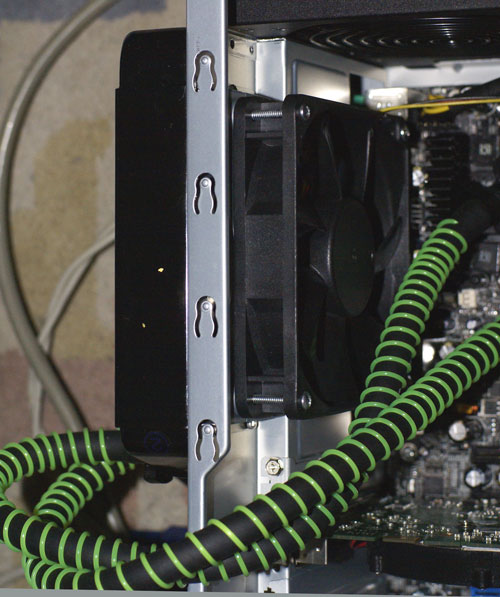
The easiest mount was a split design, where the radiator was mounted outside the case and the fan is inside the case. To use this mount you will need longer screws in some mid-tower cases and a longer pair of hoses. We found the 12" length worked fine in our case, and extra hoses are available from Swiftech.
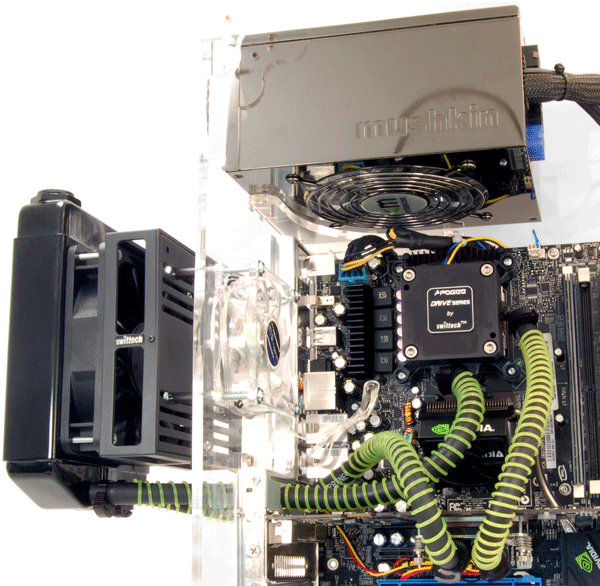
When there is not enough room for the radiator, Swiftech recommends using their "Radbox" for external mounting.
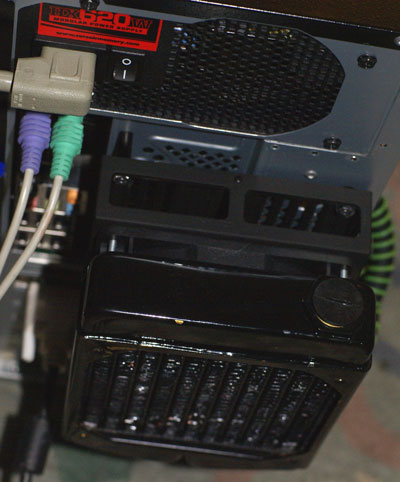
You will also need longer tubing for the Radbox install, but all the necessary screws and washers come with the Radbox from Swiftech. The Radbox kit even includes a PCI slot cover for running tubing to the outside of the case for external radiator mounting.
Performance tests were run with both the split-install configuration and the recommended Radbox external configuration. Cooling results were all but identical; the recommended external install was 0C to 2C cooler at most speeds. If your 120mm grill is not perforated enough you may have to remove the fan circle for best cooling, but the kit cooled fine on our test bed with the perforated 120mm grill intact.
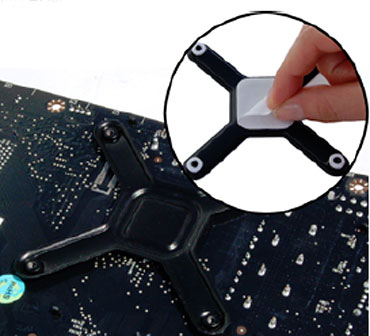
Once you have determined fit and decided on how you will mount the H2O-120 Compact you will need to assemble and leak test the water cooling system. The Intel 775 block requires a back plate so you will have to remove the motherboard to install the water cooling system. It was easiest for us to stick or tape the back plate to the motherboard and remount it for final install, because we strongly advise testing for leaks before mounting the system over the motherboard.
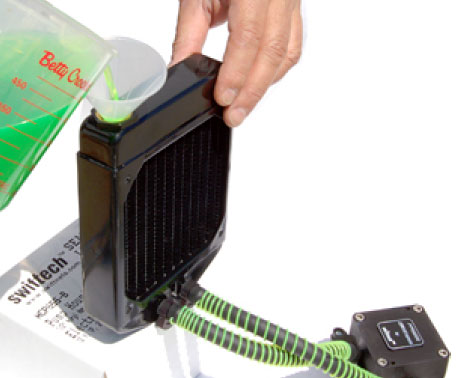
In a standard install everything is inside so you can attach the tubes, fill the system and operate the pump away from the computer. The manual includes information on how to run the power supply to test the system, before it is installed on the motherboard.
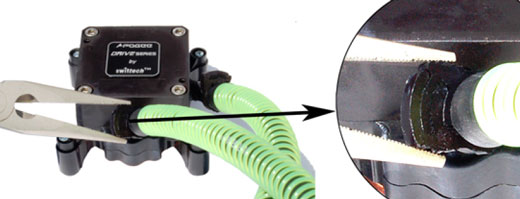
On the installs with the radiator outside the case you will have to plan assembly and water testing, since the water system should be filled after the tubes are passed through the PCI slot. The tubes for external mount were long enough that the Apogee block could dangle from inside the case to the outside for filling and leak testing. The apogee block was dangled over the back on a dry cloth for leak-testing where the tubing needed to pass though the PCI bracket.
The bottom line on installation is that the standard install is relatively simple, and it is definitely much simpler than the traditional four component water cooling systems. If you are a first-time water cooling installer and the system fits your case, 30 minutes is probably a reasonable time to install. However, if you are installing in a top PSU mid-tower case you will need to buy or order parts, carefully plan your install, and it will take an hour or more to install the system once your parts arrive. The penalty for a sloppy install without leak testing could be a dead motherboard and CPU, so we strongly recommend that you take your time and use the precautions necessary to assure you have a leak-proof water system.
Corsair Nautilus 500
When the Corsair name is mentioned, enthusiast memory is the first thing that comes to mind. However, Corsair has branched into other product lines catering to the computer enthusiast. You can now buy Corsair power supplies and Corsair's spin on the simplified water cooling system.
The Nautilus 500 was first introduced last year, but it has proven itself to be an effective and reliable CPU cooling system. For that reason the Nautilus 500 is included in this look at simpler water cooling.
Corsair uses similar components to Swiftech in their simplified water cooler, but that is where the similarity ends. Corsair's vision of better water cooling is an external appliance-like water cooling box connected to an internal CPU water block. Corsair mounts the traditional water block inside, then connects the tubing with quick disconnects to a self-contained cooling box that sits on top of the computer. The black box contains the water pump, radiator, reservoir and fan - all preassembled for easy installation.
In fact, when Corsair first introduced the Nautilus 500 they claimed an eight minute install. For an experienced installer eight minutes is definitely possible, but a first-time water cooler installer might require 15 to 20 minutes. However you measure it, the Corsair is the easiest-to-install water cooler we are aware of that uses conventional water cooling parts. The self-contained coolers that look like air coolers are easier still - but they normally must compromise performance with their small size.
The large box containing the complete Nautilus 500 system is literally filled with every bit of information you might need to understand the Corsair water cooling system.
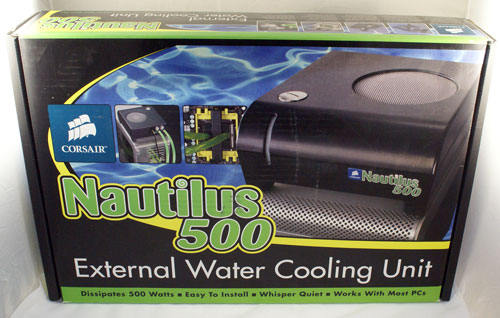
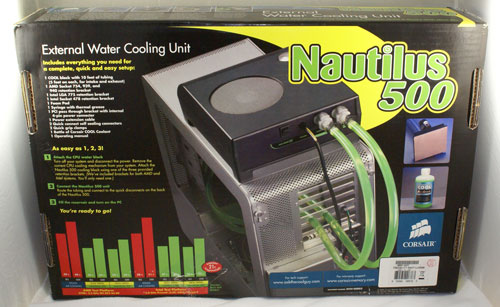
The package front shows the external box sitting on a tower case, while the rear provides a better idea of how the Nautilus 500 installs in a system and a litany of performance claims. Since the target market is likely first-time users of water cooling, it appears Corsair was very smart to provide as much info as possible about the water cooling system and how simple it is to install.
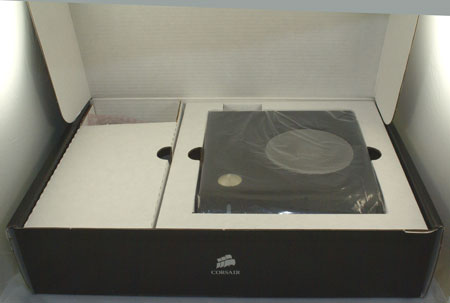
Opening the package you will find the "appliance-style" external cooler on one side and the mounting components under a large flip-up compartment on the other side. This is a first impression that emphasizes the simplicity of the Nautilus 500 compared to the complexity of most water systems.
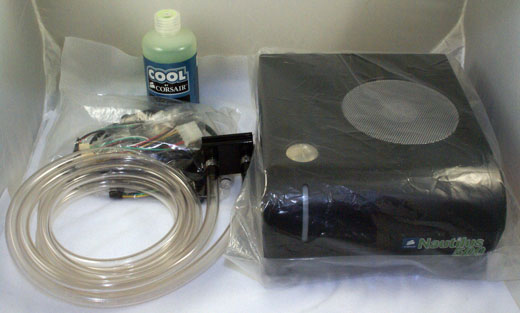
The main parts are the 8"x9"x3-3/4" (WxDxH) external cooling box and the tubing with an attached water block. The tubing is long enough for any install we tried, and it can be cut to length if you wish to shorten the tubing runs. A bottle of cooling concentrate and a bag of small parts complete the contents.
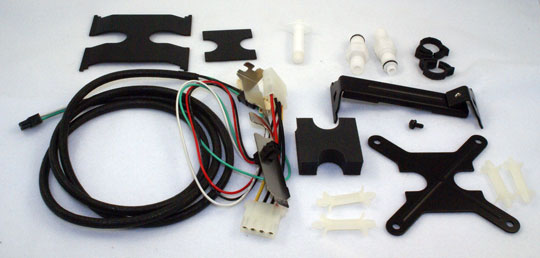
Mounting plates for either Intel or AMD are included. The parts allow installation on Intel Socket 775/478 or AMD 754/939/940. We also had no difficulty installing on Socket AM2. Quick disconnects to insert in the vinyl tubing, easy clamps, motherboard standoffs, thermal grease, a PCI slot cover for tubing and electrical pass-tough, and a power connector that plugs into the PCI slot cover and external cooling box are all contained in the small parts bag.
The fact that Corsair has already attached the vinyl tubing to the all-copper water block was impressive. Corsair also uses quick disconnects for the other end of the tubing which plugs into the external cooler. These thoughtful touches make installation a breeze, even for the first-time user who knows absolutely nothing about installing water cooling.
Installation
For Intel 775, there is no need to remove the mother board to install the water block. Begin by installing the four dual pushpins in the four holes for mounting coolers on a 775 board.
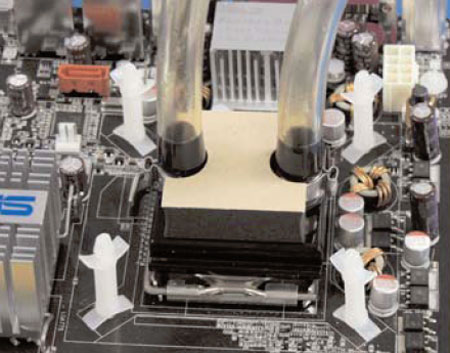
Make sure the post "legs" are in the marked area and are free from board components. Next apply the thermal paste, insert the custom cut foam block on top of the water block, and slide the 775 mounting plate in place above the compression foam.
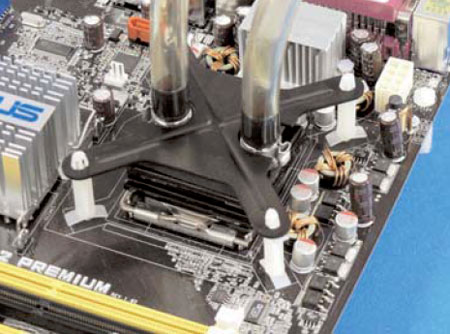
Then align the water block and push the top mounting plate onto the pushpins. If this sounds simple it's because it really is. The only real issue is the fragile pushpin posts. Make sure they are all snapped securely in place. If a pin seems loose you may need to spread the pop-though wings to make sure the pop-through clicks into place.
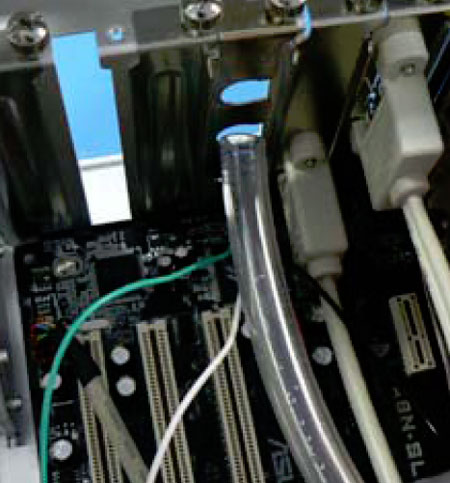
With the water block securely mounted the vinyl tubes are threaded though the PCI slot cover. It is easiest to place the tubes in the unmounted slot cover and adjust the tubing for your needs. Then attach the PCI slot cover to hold the tubes in place. Plug the Molex connector that is off the inside of the slot cover into a 4-pin Molex connector. This will power the external cooling system components.
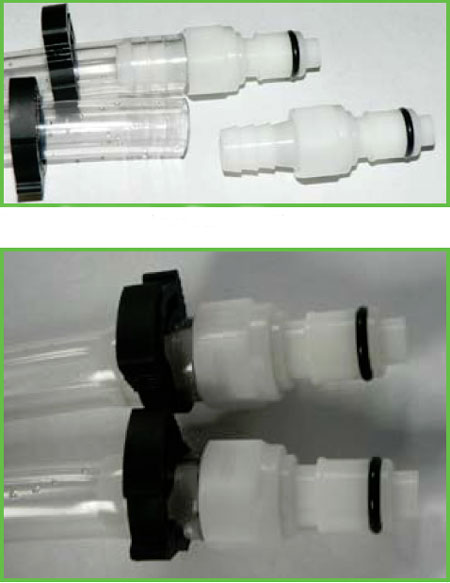
You may shorten the tubing if you wish, but consider future needs before cutting. The quick disconnects slide into the end of the vinyl tubing and are held tight by quick clamps. The finished disconnects then snap into the back of the external cooler. Plug the power cable into the outside connector on the PCI slot cover and the tiny socket on the back of the Nautilus 500.
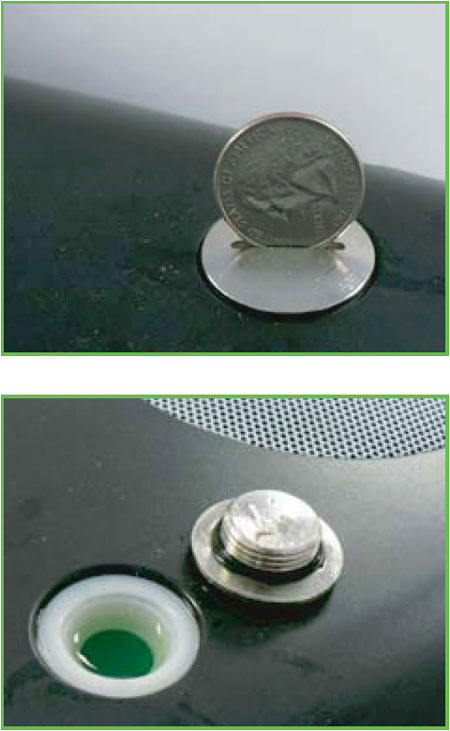
Unscrew the silver plug on top of the cooler with a coin, pour the bottle of concentrate into the cooler, and finish filling with distilled water. Turn on the computer with the plug open and let the air in the water system dissipate. Check for any leaks at the disconnects. Since the internal water block connections were made at the factory it is not absolutely necessary to check for leaks at the water block. Top off the fluid with distilled water. Since it is easy to overfill you should place a rag under the cooler box to catch any spills during the filling process. Finally, screw the plug back in with a coin.
This is really an easy install. It is much simpler, in fact, than air cooler installs where the motherboard must first be removed. However, if you move the Nautilus 500 to another system you will likely need to remove the motherboard to remove the CPU block standoffs. Yes, you can remove just the top plate by squeezing the top legs so they will release from the top plate. However, removing the posts themselves requires squeezing the pushpins from the rear of the motherboard.
Our only complaint about the whole system install is the pushpin posts, as already mentioned. They are too fragile and don't always click securely as is preferred. There is also the issue of the board dismount required for removal. While we don't have a wise suggestion for fixing this, we are confident Corsair can come up with a better 775 mount. So many parts of this system are well thought out and the push-posts appear the only shaky part of the product.
Swiftech H2O-120 Compact Specifications
Our test system is Intel Socket 775, but the H2O-120 Compact will also mount on socket AM2 as well as socket 754/939/940 and socket F. All accessories for mounting are included, but mounting on AMD/AM2 sockets requires adapting the Apogee drive block by replacing the bottom half of the Apogee with an AMD specific mounting block. The CPU cage is then removed from the motherboard for the two or four screw direct mount of the drive block
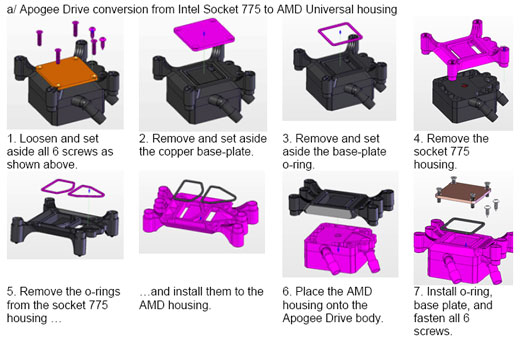
| Apogee Drive Block Specifications | |
| Motor | Electronically commutated, brushless 12V DC, spherical motor |
| Nominal Current | 0.69A |
| Weight | 286g (10.1 ounces) |
| Material | Diamond Pin Matrix copper base plate |
| Fittings | 3/8" barbs fittings for input and output |
| Normal Discharge | 300 LPH |
| Nominal Head | 10 ft |
| MTBF | 50,000 hours |
The included fan is specified at a high 81.3 CFM at 12V, but it is rated at a bit higher noise than we normally see at this output. The 12V rated noise is 36 dB(A). Lowering the fan voltage to 7V with the included electrical adapter drops the noise to 26 dB(A) with the trade-off of much lower airflow. Sleeve bearings are not noted for a long service life, but Swiftech does not specify an average MTBF for this fan.
| 120mm Fan Specifications | |
| Model | RDM1225S |
| Fan Size | 120mm x 120mm x 25mm |
| Fan Type | Low Noise Sleeve Bearing |
| Maximum Fan Speed | 2000 RPM |
| Maximum Noise Level | 36 dB(A) @ 12V, 26 dB(A) @ 7V |
| Maximum Airflow | 81.3 CFM |
| Current | 0.23A |
| Static Pressure | 27mm H2O |
The Reservoir/Heat Exchanger utilizes louvered copper fins for best performance. Swiftech claims the system is optimized for high performance at low fan speed where low noise is required.
| Radiator/Reservoir Specification | |
| Model | MCR120-Res Heat Exchanger |
| Description | 120mm Class Radiator with built-in reservoir. Designed for sealed system with 5 years between refilling |
| Dimensions | 7in x 5in x 1-3/8in (2" thick including barbs) |
| Material | Louvered copper fins, brass tubes & body |
| Design | Optimized for high performance at low fan speed for low noise operations |
| Fittings | Built-in 3/8 in barbs |
The Apogee Drive Block is extremely small compared to the size and weight of most of today's better air coolers. This makes the Apogee drive block an easy fit on virtually any motherboard. The only potential issue is the side-mounted 3/8" barbs on the combo block. On some motherboards with tall heatsinks for the power MOSFETs the barbs are potentially not tall enough to clear the tall MOSFET sinks However, we did not encounter this issue with any of the boards we looked at for potential mounting problems.
There are no mounting issues with the EVGA 680i board. Installation was also an easy task on the ASUS Striker and ASUS Commando, and on the two new P35 boards - the ASUS P5K Deluxe and P5K3 Deluxe. The P5K3 Deluxe will likely become a fit test for any motherboard, since the heatpipes completely circle the CPU socket and connect various cooling heatsinks around the CPU socket.
Corsair Nautilus 500 Specifications
The Nautilus 500 was tested on Intel Socket 775. The kit also includes retention brackets for Intel socket 478 and AMD 754/939/940/AM2 sockets. The vinyl tubing for the circulating water is attached to the water block at the factory. The water block remains the same in all possible installations and only the retention mechanism for mounting varies among the different installations. This is an important consideration since this approach ensures that the critical internal water connection is assembled at the factory and already tested for leaks.
| Water Pump | |
| Motor | Electronically commutated, brushless 12V DC, spherical Motor |
| Voltage Range | 8V to 13.2V |
| Max Static Pressure | 22 PSI |
| Normal Discharge | 350 LPH (@12V) |
| Nominal Head | 13.05 ft |
The supporting components and self-contained design makes some small differences in the pump specifications between the Corsair and Swiftech designs. Corsair has also selected a different fan to be integrated in the external cooler. The 1800 RPM Nautilus 500 fan has a maximum air flow of 74.4 CFM, which is slightly less than the 81.3 CFM of the Swiftech. However, static pressure is higher on the Corsair fan.
| 120mm Fan Specifications | |
| Fan Size | 120mm x 120mm x 25mm |
| Maximum Fan Speed | 1800 RPM |
| Maximum Airflow | 74.4 CFM |
| Current | 0.3A |
| Static Pressure | 32mm H2O |
| CPU Block | |
| Description | 100% solid copper supporting Delphi Micro-Channel Technology |
| Material | Solid Copper |
| Fittings | Built-in 3/8 in barbs |
The CPU clock looks very similar to the water block used in the Swiftech H2O-120 Compact. The Corsair design uses a stand-alone water block and does not integrate the block and pump as we saw in the Swiftech. This moves the pump noise from inside the case, as in the Swiftech, to outside the case in the cooling box on the Corsair. Which is the better design is a matter for debate, but as you'll see shortly we consider both designs noisier than the best air cooler designs.
There was no problem with fitting the Nautilus 500 waterblock to any motherboard we tested, and in fact we doubt you can find a motherboard that cannot mount the Corsair water block. Since the water block is standalone in the Corsair design there is no potential issue with side barbs as we saw on the Swiftech
New CPU Cooling Test Configuration
Cooling tests were first run on our existing test bed, which is the EVGA NVIDIA 680i SLI motherboard. Temperatures were measured using the NVIDIA Monitor temperature measurement utility, which is part of the nTune program.
All Cooling tests were then repeated on the new cooling test bed, which is a Rosewill R604-P-SL case sold without a power supply. The Rosewill is a www.Newegg.com brand typical of a moderately priced mid-tower case our readers might own. It was chosen because it is a Newegg top seller and includes a variable front intake louver and a quiet 120mm exhaust fan at the rear of the case. The case is also screw-less with components held in place by plastic holders instead of metal to metal connections. This appears to reduce case vibration and noise.
The new power supply is the Corsair HX620W, which has earned our respect as an exceptionally quiet PSU with a variable speed exhaust fan and a down facing intake fan mounted just above the CPU space in the case. To eliminate the video card as a source of noise we have moved to a fanless video card, currently a GeForce 7600 GS. Plans are to move to fanless DirectX 10 capable card in this test bed in the near future.
The new motherboard is the ASUS P5K Deluxe. This P35 chipset motherboard has exhibited outstanding overclocking capabilities in our testing, and it can also mount the newest 1333FSB Intel Core processors and can handle our existing high-speed DDR2 memory. The P5K3 uses heatsinks and heatpipes to cool board components so all motherboard cooling is passive.
Other components in the cooling test bed are generally the same as those used in our previous motherboard and memory test bed. We will feature the new test bed and its noise metrics in an upcoming cooling system review. The goal was to remove fans that might produce noise wherever possible, improve internal airflow, reduce the power supply noise floor, and eliminate the video card as a noise source. While we did add a 120mm exhaust fan to improve case airflow, the chosen exhaust fan is very low noise and will be replaced by the lowest noise 120mm fan when the 120mm fan roundup is completed.
| Cooling Performance Test Configuration | |
| Processor | Intel Core 2 Duo X6800 (Dual-core, 2.93GHz, 4MB Unified Cache) |
| RAM | 2x1GB Corsair Dominator PC2-8888 (DDR2-1111) |
| Hard Drive(s) | Hitachi 250GB SATA2 enabled (16MB Buffer) |
| Video Card | NVIDIA 7600GS (fanless) - All Standard Tests |
| Platform Drivers | NVIDIA 9.53 |
| NVIDIA nTune Intel TAT CoreTemp |
5.05.22.00 (1/16/2007) Version 2.05.2006.0427 Version 0.95 |
| Video Drivers | NVIDIA 93.71 |
| CPU Cooling | Swiftech H2O-120 Compact Corsair Nautilus 500 Thermalright Ultima-90 ZEROtherm BTF90 Xigmatek AIO (AIO-S800P) Evercool Silver Knight Enzotech Ultra-X 3RSystem iCEAGE Thermaltake Big Typhoon VX Thermaltake MaxOrb Scythe Andy Samurai Master Cooler Master Gemini II Noctua NH-U12F Asus Silent Square Pro Scythe Ninja Plus Rev. B OCZ Vindicator Thermalright Ultra-120 Extreme Thermalright Ultra-120 Scythe Infinity Zalman CNS9700 Zalman CNS9500 Cooler Master Hyper 6+ Vigor Monsoon II Lite Thermalright MST-9775 Scythe Katana Tuniq Tower 120 Intel Stock HSF for X6800 |
| Power Supply | Corsair HX620W OCZ PowerStream 520W |
| Motherboards | Asus P5K Deluxe (Intel P35) EVGA nForce 680i SLI (NVIDIA 680i) |
| Operating System(s) | Windows XP Professional SP2 |
| BIOS | EVGA Award P26 (1/12/2007) Asus AMI 0501 (06/26/2007) |
All cooling tests are run with the components mounted in a standard mid-tower case. The idle and stress temperature tests are run with the case closed and standing as it would in most home setups. We do not use auxiliary fans in the test cooling case, except for the Northbridge fan attached to the 680i for overclocking. Room temperature is measured before beginning the cooler tests and is maintained in the 20 to 22C (68 to 72F) range for all testing.
Both Swiftech and Corsair provided a small tube of Arctic Silver Ceramic premium thermal grease with their water cooling kits. However, for consistency of test results we tested with our standard premium silver-colored thermal compound. In our experience the thermal compound used makes little to no difference in cooling test results. This is particularly true now that processors ship with a large manufacturer-installed heatspreader. Our current test procedure uses this standard high-quality silver-colored thermal paste for all cooler reviews.
We first test the stock Intel air cooler at standard X6800 speed, measuring the CPU temperature at idle. The CPU is then stressed by running continuous loops of the Far Cry River demo. The same tests are repeated at the highest stable overclock we can achieve with the stock cooler. Stable in this case means the ability to handle our Far Cry looping for at least 30 minutes.
The same benchmarks are then run on the coolers under test at stock, highest stock cooler OC speed (3.73GHz), and the highest OC that can be achieved in the same setup with the cooler being tested. This allows measurement of the cooling efficiency of the test unit compared to stock and the improvement in overclocking capabilities, if any, from using the test cooler.
The cooling test results of both water cooling kits are compared to a representative sample of air cooling results with the NVIDIA Monitor program on the EVGA 680i. This is done for a consistent comparison of water cooler test results to earlier air cooler results. We then repeated testing on the new test bed measuring results with both Intel TAT (Thermal Analysis Tool) and CoreTemp, a well-known and widely used shareware program for core temperature measurement. Both results are reported in additional test results so they can be compared and contrasted to each other and to NVIDIA Monitor results.
Noise Levels
In addition to cooling efficiency and overclocking abilities, users shopping for CPU cooling solutions may also be interested in the noise levels of the cooling devices they are considering. Noise levels are measured with the case on its side using a C.E.M. DT-8850 Sound Level meter. This meter allows accurate sound level measurements from 35bdB to 130dB with a resolution of 0.1dB and an accuracy of 1.5dB. This is sufficient for our needs in these tests, as measurement starts at the level of a relatively quiet room. Our own test room, with all computers and fans turned off, has a room noise level of 36.4dB. Procedures for measuring cooling system noise are described on page seven which reports measured noise results comparing the stock Intel cooler and recently tested CPU coolers to the Swiftech H2O-120 Compact and Corsair Nautilus 500 water cooling kits.
Cooling at Stock Speed
Some users will never overclock their CPU, but they still want to run the coolest CPU temperatures possible to enhance stability and extend CPU life. It is conventional wisdom that water cools better, but is that really true? The Swiftech H2O-120 Compact and Corsair Nautilus 500 both use high-output and relatively quiet 120mm fans - the same fan configuration used in the best air coolers. Both water coolers are reported, with the Corsair results in red and the Swiftech in orange.
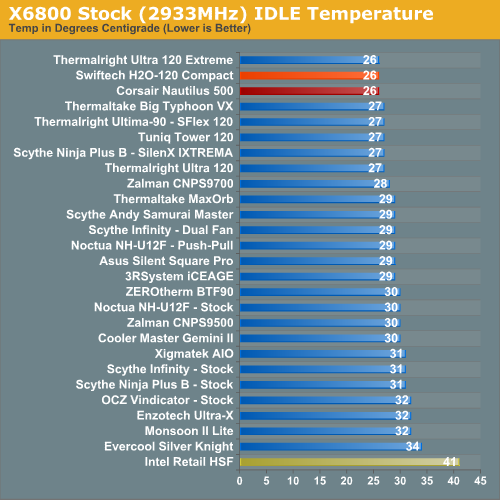
The very good Intel stock air cooler keeps the X6800 at 41C at idle, compared to the Corsair Nautilus 500 and Swiftech H2O-120 Compact which both kept idle temperature to a very low 26C. The 26C results are the best ever seen in AnandTech idle cooler benchmarking and match the top-performing Thermalright Ultra-120 eXtreme. The Tuniq120, the Ultra-120, and the Ultima-90 with a 120mm fan are one degree higher at 27C. All these results are dramatic improvements over the Intel stock cooler performance at 41C, and they represent an excellent performance by the water cooling kits, which match the best air cooler tested at stock idle.
| Intel P35 Idle Stock Speed - Temperature in Degrees Celsius | |
| Swiftech H2O - TAT | 28 |
| Swiftech H2O - CoreTemp | 24 |
| Corsair Nautilus 500 - TAT | 27 |
| Corsair Nautilus 500 - CoreTemp | 24 |
Test results under the same conditions on the Intel P35 platform show the same pattern, but Intel TAT results are generally 1-2C higher than the NVIDIA Monitor results with the same CPU. CoreTemp shows idle temps about 2C cooler than NVIDIA Monitor.
It is more difficult to effectively simulate a computer being stressed by all of the conditions it might be exposed to in different operating environments. For most home users CPU power is most taxed with contemporary gaming. Therefore our stress test simulates playing a demanding game. The Far Cry River demo is looped for 30 minutes and the CPU temperature is captured at 4 second intervals with the NVIDIA Monitor "logging" option. The highest temperature during the load test is then reported. Momentary spikes are ignored, as we report a sustained high-level temp that you can expect to find in this recording configuration. This test configuration roughly equates to an 80% CPU load test using Intel TAT.
Cooling efficiency of the Corsair and Swiftech water cooling systems was then compared under load conditions at stock speed to the retail HSF and other recently tested CPU coolers.
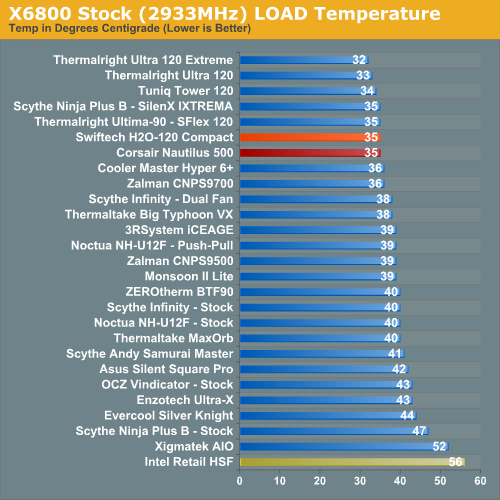
The Corsair Nautilus 500 and Swiftech H2O-120 Compact under load at stock speeds both reach a maximum temperature of 35C. This is one of the top performances under these conditions, but the Thermalright Ultra-120 eXtreme (32C), Ultra-120 (33C), and Tuniq Tower 120 (34C) all do a bit better in this test. The Thermalright Ultima-90 with an S-FLEX 120 fan matches the 35C as does the Scythe Ninja Plus B with a SilenX IXTREMA fan. This compares to the stock Intel air cooler at 56C under load.
It was really expected that the water coolers would outperform the best air coolers under load, since they can theoretically dissipate more wattage. The water cooling performance is still excellent under load, but a few top air coolers do even better than water cooling.
| Intel P35 Load Stock Speed - Temperature in Degrees Celsius | |
| Swiftech H2O - TAT | 40 |
| Swiftech H2O - CoreTemp | 37 |
| Corsair Nautilus 500 - TAT | 40 |
| Corsair Nautilus 500 - CoreTemp | 37 |
The temperature pattern with TAT and CoreTemp on the P35 is a bit different under load conditions than Idle. All four results are higher (poorer) than the NVIDIA Monitor results on the 680i. CoreTemp results under the same test conditions are a couple of degrees higher than NVIDIA Monitor, while TAT results were a surprising 5C higher with both water cooling systems compared to the same system test results measured with NVIDIA Monitor.
The purpose of these comparisons of the same tests measured using three different core temperature utilities is to get a better understanding of how each program compares in temperature measurement under different test conditions. This will hopefully provide the insight needed to select a standardized program for temperature measurements on our new cooling test bed.
Noise
Everyone "knows" that water cooling is quieter than air cooling. We have been told that for years - so much so that many enthusiasts no longer question this idea. That is certainly true when comparing water cooling to the small, loud fans on air coolers of the past. However, the current top heatpipe towers use large, high-output, low-noise fans for cooling and it is time again to challenge conventional wisdom based on out-of-date "facts".
For many enthusiasts upgrading cooling, the goal is maximum stable overclock, and they will live with the inconvenience of a louder system. For other users silence is the most important factor, and these users will forgo maximum overclocking if that increases system noise levels. That is why many who value silence choose water cooling.
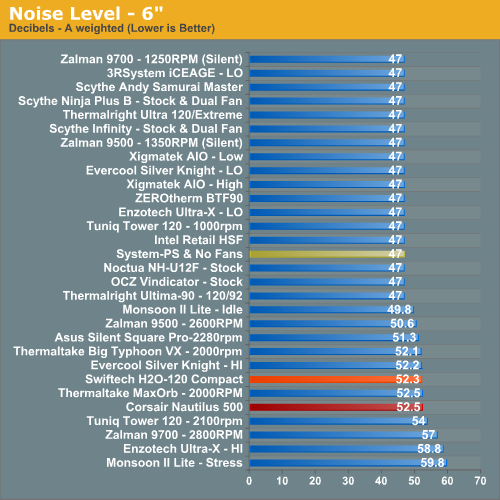
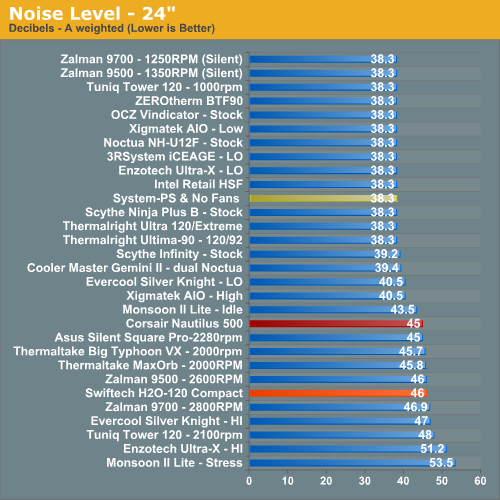
The belief was that water cooling noise levels would be so low that pages would be required to detail the lower noise levels of our new cooler test bed in complete detail. Once again we're totally shocked that these two cooling kits from major players using top water cooling components are among the noisiest cooling systems tested so far at AnandTech.
Assuming something must be wrong with our results or the 120mm fans in the water cooling kits, we tested many times and got the same results. Where then, does the 45-46 dB(A) noise come from at 24", when the system noise floor is 38.3 dB(A) on the old test bed and much lower on the new cooling test bed? What is generating the 52.3 to 52.5 dB(A) noise at 6" where the system noise floor is worst case 47 dB(A) and the new test bed is even lower?
It turns out the noise culprit is the water pump on both systems. Measured noise at 24" with the pump and fan running was around 46 dB(A) on the Swiftech, where noise level with the pump only and the fan disconnected for a short time was 45.5 dB(A). Results with the Nautilus were similar, proving the offender in noise is the water pump. With pump noise so high it was pointless to test the fan at lower voltage since it was only adding 0.5 dB(A) at full speed and highest noise.
It is very important, however, to talk about perceived noise. The water coolers measure very high noise levels, but the noise frequencies are not particularly irritating. The pump noise is a low hum instead of a high-pitched scream and most users would rate the noise as audible, but not particularly annoying.
There is also the comparison of the internal mount water pump on the Swiftech H2O-120 Compact and the external mount water pump on the Corsair Nautilus 500. Our test method with the open case side is the worst possible noise you can get with the Swiftech. If you close the case side the noise drops about 5 dB(A) with the Swiftech, which is much quieter but not silent or competitive with the best heatpipe towers using high-output low noise fans. The Corsair external cooler noise, on the other hand, is what you get. There are no noise producers inside the case that can be damped with a Corsair external water cooler install.
Scaling of Cooling Performance
Excellent performance at stock speeds is one thing, but we were interested in seeing how both these water cooling kits scaled in cooling higher overclocks.
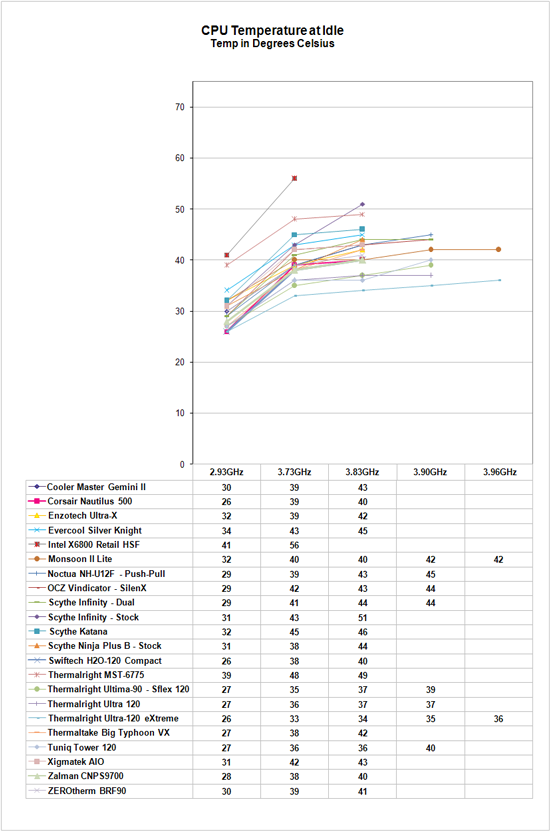 |
| Click to enlarge |
At 2.93GHz the retail HSF is running at 41C, compared to 26C with both the Corsair and Swiftech. This is a delta of 15C. The delta generally becomes greater with the better air coolers as the overclock increases. Is this also true with water cooling?
At 3.73GHz idle the retail HSF is 56C compared to the Swiftech H2O-120 Compact and the Corsair Nautilus 500 at 38C and 39C - a delta of 17C to 18C. The cooling performance of either water system is significantly better than the Intel retail cooler at idle. At the higher 3.73GHz, however, the water coolers are outperformed by most top air coolers.
Looking closely at the curves of the top coolers tested, the water coolers mirror the performance of high-performing air coolers just below the top performers. The water coolers compare favorably to the Scythe Infinity, the Noctua NH-U12F stock, the OCZ Vindicator and the new crop of down facing coolers like the Enzotech Ultra-X and Gemini II. This is certainly good company near the top of the tested air coolers, but the Corsair Nautilus 500 and Swiftech H20-120 Compact do not outperform the top air coolers in any tests in our cooler test suite.
| Intel P35 Idle Temperatures | ||||
| 2.93 GHz | 3.73GHz | 3.83GHz | 3.97GHz | |
| Swiftech H2O TAT |
28 | 41 | 42 | 45 |
| Swiftech H2O CoreTemp |
24 | 39 | 40 | 42 |
| Corsair Nautilus TAT |
27 | 39 | 42 | 45 |
| Corsair Nautilus CoreTemp |
24 | 37 | 40 | 42 |
Scaling performance results with TAT and CoreTemp on the P35 vary considerably from NVIDIA Monitor test results. TAT results follow a similar pattern to NVIDIA Monitor, but results were 2-6C higher in TAT. CoreTemp results are closer with variations over the overclock range of -2C to +4C compared to NVIDIA Monitor.
Cooling efficiency of the H2O-120 Compact and Nautilus 500 is then compared under load conditions to the retail HSF and other recently tested CPU coolers. Load testing can be very revealing of a cooler's efficiency. A basically flat line, particularly form 3.73GHz upward, indicates the cooler is still in its best cooling range. A line that is increasing rapidly indicates a cooler nearing the end of its ability to cool efficiently. Lines which parallel the best coolers over a range of values indicate similar cooling efficiency.
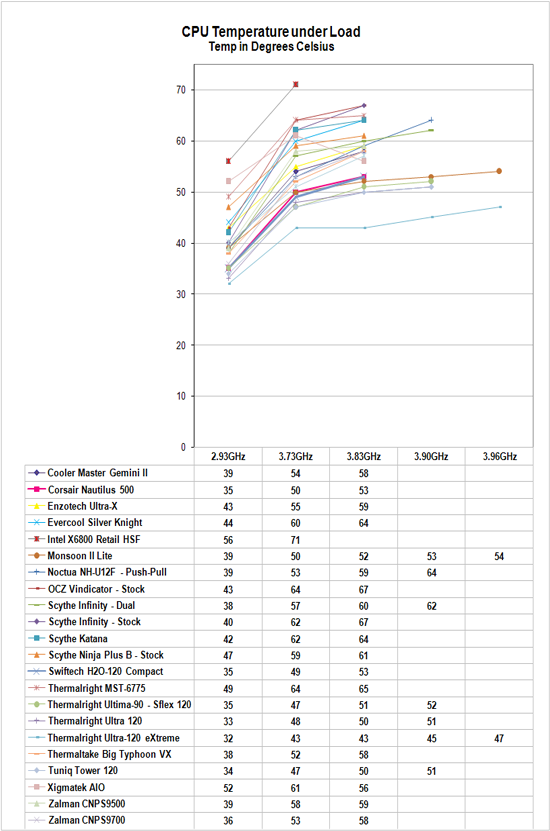 |
| Click to enlarge |
Load patterns from 2.93GHz to the 3.83GHz overclock range are similar to idle results. Both water coolers mirror the performance curves of coolers very near the top of air cooling test results but they do not match the very top air coolers. The water cooling results with both water kits are clearly better than the average air cooler, but neither water cooler outperforms the top air coolers in any way.
We expected good performance and cooling at high overclocks with the Corsair Nautilus 500 and the Swiftech H2O-120 Compact. However, neither water cooler out-overclocked nor out-performed the Thermalrights, Tuniq 120, or push-pull OCZ Vindicator, push-pull Noctua, or push-pull Scythe Infinity.
| Intel P35 Load Temperatures | ||||
| 2.93 GHz | 3.73GHz | 3.83GHz | 3.97GHz | |
| Swiftech H2O TAT |
40 | 55 | 57 | 60 |
| Swiftech H2O CoreTemp |
37 | 53 | 55 | 58 |
| Corsair Nautilus TAT |
40 | 55 | 57 | 62 |
| Corsair Nautilus CoreTemp |
37 | 53 | 55 | 59 |
TAT and CoreTemp results follow a pattern of performance scaling under load similar to that seen in idle testing. The TAT and CoreTemp results are even higher than NVIDIA Monitor under load testing. TAT is 5-7C higher and CoreTemp is 2-6C higher than the NVIDIA Monitor results.
Overclocking
As cooling solutions do a better job of keeping the CPU at a lower temperature, it is reasonable to expect the overclocking capabilities of the CPU will increase. In each test of a cooler we measure the highest stable overclock of a standard X6800 processor under the following conditions:
CPU Multiplier: 14x (Stock 11x)
CPU voltage: 1.5875V
FSB Voltage: 1.30V
Memory Voltage: 2.20V
nForce SPP Voltage: 1.35V
nForce MCP Voltage: 1.7V
HT nForce SPP <-> MCP: Auto
Memory is set to Auto timings on the 680i and memory speed is linked to the FSB for the overclocking tests. This removes memory as any kind of impediment to the maximum stable overclock. Linked settings on the 680i are a 1066FSB to a DDR2 memory speed of DDR2-800. As FSB is raised the linked memory speed increases in proportion. The same processor is used in all cooling tests to ensure comparable results.
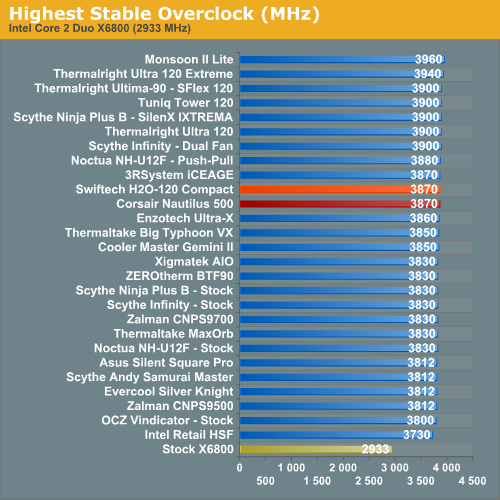
The Swiftech H2O-120 Compact and Corsair Nautilus 500 both topped out at 3870 MHz - near the top of tested air coolers but below the 3.94 GHz of the Thermalright Ultra-120 eXtreme, and the 3.90GHz of five tested air coolers. Once again test results - this time in overclocking - are near the top but do not match or exceed the best air coolers tested at AnandTech.
It was quite a surprise to find overclocks on the P35 motherboard also topped out at 3.87 GHz, particularly since we could not duplicate the 14X base multiplier on the ASUS P5K Deluxe motherboard. We achieved 3.87 GHz by choosing the 333 strap and setting a FSB of 352 with the 11X multiplier. This turned out to be the highest stable overclock on the P35 board with either water cooler - the same results found on the EVGA 680i board.
As stated many times, the overclocking abilities of the CPU will vary at the top, depending on the CPU. This particular CPU does higher FSB speeds than any X6800 we have tested, but the 3.9GHz top speed with the Tuniq is pretty average among the X6800 processors we have tested with Tuniq cooling. A few of the other processors tested with the best air coolers reach just over 4.0GHz, but the range has been 3.8 to 4.0GHz. Stock cooling generally tops out 200 to 400 MHz lower, depending on the CPU, on the processors tested in our lab.
Final Words
"Conventional wisdom" tells us that water cooling systems will always cool better than air coolers and water coolers will always be lower noise than the best air coolers. Any computer enthusiast has heard this ad nauseum and probably repeated these "truths" to their friends. Unfortunately these conventional wisdom maxims were coined a few years ago when air coolers were heavy blocks of copper, heatpipes weren't used on coolers, and the cooling fans were small, high-pitched screamers.
Whether everyone has noticed it or not, air coolers have been undergoing a revolution since these maxims were genuine truths. Fast forward to today and you will find the heatpipe tower the dominant design for top air cooling. The liquid-filled heatpipes provide many of the benefits of conventional water cooling and the fan most often paired with these heatpipe towers is a side-blowing, rear-facing 120mm fan with high output combined with low noise.
With these developments firmly in mind it was time to put "conventional wisdom" under the microscope again. The worthy test subjects for examining these water cooling "truths" are the Corsair Nautilus 500 external water cooling system and the Swiftech H2O-120 Compact. Both these water cooling systems are also the beneficiaries of the evolutionary development of water cooling since they both combine top water cooling components in simpler to install water cooling kits. They are also reasonable as water cooling kits are concerned, at around $130 to $150. However, even at these excellent prices the water cooling kits are two to three times the price of the top air coolers.
The cooling tests are now complete and it is time to look at each area where water cooling was considered superior to answer whether water cooling is still better than air.
Cooling Performance: Both the Corsair and Swiftech water coolers mirror the second tier of air coolers in cooling efficiency. They match the best air coolers we have tested at stock idle only. At all other speeds and load conditions the top three or four air coolers out-cooled water.
Overclocking: Seven air coolers tested by AnandTech overclock higher than the Swiftech H2O-120 Compact and the Corsair Nautilus 500. The Thermalright designs do use the convex (bowed) base plate which has been shown to increase cooling by 2C to 3C and therefore increase overclocks. Swiftech has been shipping bowed base plates on their top water blocks and they will add the bowed base to the H2O-120 Compact. That may improve performance of the Swiftech water system to near parity with the top air coolers. The operative term is near parity. We have yet to test a water kit below $300 cost that can match or outperform a top $50 to $75 air cooler.
Noise: The Swiftech and Corsair water systems were noisier than almost any air system we have tested. With air coolers the noise can only come from the fan and most fans can be replaced with a quiet, high-output fan. Noise from the H2O-120 Compact and Nautilus 500 water systems is mostly from the buzzing and humming of the water pump and it is not easily corrected. Subjectively the water cooling noise, while measuring high, is not particularly annoying in frequency. Many users will find it easy to live with. In this regard the Swiftech has the greatest potential for damping noise since the water pump is inside the case where the Corsair mounts the water pump outside the case.
Flexibility: Water cooling enthusiasts rightly point out that you can effectively cool hot VGA cards by just adding a VGA block to your water system. Or tame a hot chipset with a chipset block. That is true, and even these reasonable kits offer the option of driving additional VGA and system cooling blocks. Air can never offer this level of flexibility, but the cost will be higher than you expect and it might be cheaper to buy one of the new self-contained water-cooled VGA cards to use with your top-performing air cooler. Scaling of water cooling performance when it has to deal with GPUs and chipsets as well as the CPU is also something that needs to be considered.
Finally, there are two areas where air cooling is considered the superior solution. Do comparisons still show air to be superior to water in these areas?
Ease of Installation: In general air cooling is a much simpler installation. Also, if you're sloppy in an air installation your system might shut down so you can correct the problem. If you're sloppy with a water cooling installation your board may be fried. The two water systems tested here were designed for easier water installation. With the right case the Swiftech is fairly easy, but it is quite complicated if you plan to use it in a common top-mounted PSU mid-tower case and extra parts are required. The Corsair is an extremely easy install that works in every case we have available for testing. It's so easy it will take less time to install than top air coolers that require a motherboard removal to install the air cooler.
Value: Water cooling systems have been dropping in price while the prices for top air coolers have been increasing. Still any water cooling system that even has a chance to compete in performance with the top air coolers will cost $130 to $300 for the kit. Top air coolers cost $50 to $75. At one half to one sixth the price top air cooling is still a very good value by comparison.
The Bottom Line
The next time a computer friend tells you water cooling performs better or is quieter than air cooling, tell him his information is out of date. Air coolers have evolved to the point where a top $50 to $75 air cooler will normally outperform a water cooling kit at $300 or below. The best air coolers are much cheaper, easier to install, lower in noise, and provide better overclocking results than water cooling kits that are up to six times more expensive.
However, water cooling is still very desirable if you also want to cool a hot video card or a hot chipset, since almost every available water cooling kit allows the easy addition of VGA and chipset blocks. For many this one feature, the flexibility of additional water blocks, is reason enough to run water instead.
Our tests of the "Easier to Install" Corsair Nautilus 500 and Swiftech H2O-120 Compact show both systems to be worthy competitors at their price points. Both systems cool to levels just below the top air coolers, and both facilitate overclocks just below the top air coolers. Neither water system, however, can match the performance of the top seven or eight air coolers tested at AnandTech, which sell for one third to one half the price of either the Swiftech or Corsair water cooling kit.
If your planned install is a full tower case or a mid-tower with a bottom mount power supply then either the Corsair or Swiftech will be easy to install, with the Swiftech offering more flexibility in controlling water pump noise. If you plan to install in a more common top-mounted PSU mid-tower case the Corsair Nautilus 500 is the better choice, since the Swiftech will require additional parts for an external of split install.
In the end the only persuasive reason to buy a sub $300 water cooling system is if you want to add VGA and/or chipset cooling. There seems to be a trend by some enthusiasts to put together extremely large water cooling systems with multiple large banks of radiators and cooling fans. Some featured at enthusiast sites look more like car radiators than computer water cooling systems. These systems can undoubtedly cool better than a $50 to $75 top air cooler but they also cost substantially more than $300. You have to spend more than $300 on water cooling that might outperform the best air coolers.
We asked when we started this review "Is water better?". The clear answer is NO, after comparing the Corsair Nautilus 500 and Swiftech H2O-120 Compact to the top air coolers. Water cooling comes close to top air performance in current designs but it did not outperform top air cooling in any test results. Upcoming improvements in block design may bring water performance closer to the best air coolers but water is not likely to provide better performance than air in kits priced at under $300. Air is also much quieter than these water kits. For most enthusiasts air cooling is the better value, better performer, and lower noise system. Unless you plan to also water cool your video card and/or chipset there is no real reason to buy water cooling instead.







